O'Day 25 Yacht: Five Critical Things To Look For When You Buy A Compact Cruiser (1976)
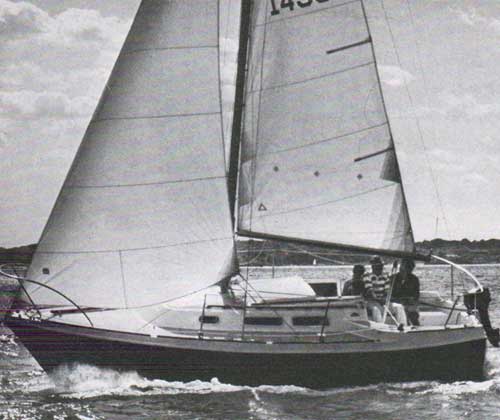
(And how the O'Day 25 measures up )
1. Look For Sailing Performance
No matter how sleek she looks, how opulent below, no cruiser is worth considering if she won't perform under sail.
- Will she go to windward in a chop?
- Will she sail at all if the wind is light?
- Is she a stubborn monster when you want to tack?
Here's how the O'Day 25 measures up:
- We built the O'Day 25 with both a centerboard and a keel. There's 1525 pounds of lead in the keel to keep her on her feet. And make her sure and seaworthy.
- The centerboard gives her six foot draft. Which makes her fast and close winded. And helps her track when the waves build up.
- But she's a gunkholer too. With 2' 3" draft (board up), for slipping into secluded coves. Or exploring shallow bays and rivers.
- We fitted her with a powerful outboard rudder. So the O'Day 25 doesn't hesitate when you want to come about. She handles with unusual precision.
- She has what offshore sailors call a "forgiving" hull. She compensates for the little errors even expert skippers sometimes make.
2. Look for a Cabin That Works
A spacious cabin is important, but what really counts on a cruising boat is the way the space is used.
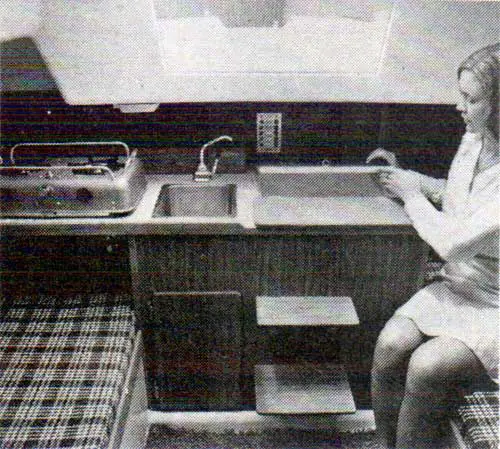
Privacy is essential. For people who must live in each other's company for days on end. Warmth is welcome, when it's wet and forbidding outside.
You must have decent space for cooking. Space for keeping clothes and bedding dry. Space for plotting a course in comfort while the boat's heeled over.
Here's how the O'Day 25 measures up:
- Raymond Hunt and Associates designed our boat. They insisted on a galley usable under sail. They put it at the cabin's after end. Close to amidships, where the pitching of the hull is the least. And close to the companionway, so the cook can keep in touch with the cockpit crew.
- We layed out galley storage where you can get at things without having to crawl into the bilges or reach over boiling pots on the stove.
- Our designers also insisted on a cabin table stable enough to use for navigation. Big enough for four at meals. Four full-sized people.
- We built in bunks for five. You may not use them all. But we know how handy an extra bunk can be -- when you need some place to quickly stow a sail. Or spread out a series of bulky charts.
- The bulkhead between the cabins makes the O'Day 25 an honest, private, two-cabin boat. And the passageway between closes with a solid door. Not a flimsy curtain.
- There's plenty of storage: under the bunks, in cockpit lockers, on main cabin shelves, and up in the forepeak. For the endless anchor lines and sails, spare batteries and tools, fittings, gadgets and gear that make a cruiser self-sufficient away from home.
3. Insist On Safety
Open water demands respect. It's foolish to count on any boat that isn't designed to face the worst.
Here's how the O'Day 25 measures up:
- Her heavy lead keel and beamy hull work together to make the boat self-righting, and help to keep her stable.
- The cockpit is self draining, through a scupper in the transom. So an unexpected wave won't leave her stern heavy in a stormy sea.
- There's jiffy reefing, as standard gear, to reduce sail area easily and swiftly -- even after the wind's begun to gather strength.
- We use only quality equipment -- for deck hardware, spars and rigging, so nothing vital should let go in heavy weather -- when it's hardest to fix and you need it most.
- Most important for your safety, we build the boat in the O'Day tradition. Backed up by what we've learned in building more than 25,000 sailboats.
4. Consider the Flexibility of a Trailerable Boat
Boatyard winter storage for an ordinary 25-footer can cost you several hundred dollars -- every year.
A trailerable cruiser can be stored at home. You can sail her on different bodies of water hundreds of miles apart.
You can take her with you on vacations. But a sailboat must be designed especially for trailering.
Here's how the O'Day 25 measures up:
- For all her features, she weighs just 4,400 pounds, which makes her easier to handle on the road.
- Her draft is only 2' 3". Her outboard rudder is removable. And her keel, with the centerboard up, is blunt and solid. So she's easily floated on or off her trailer but still has 6' draft, with the centerboard down, for sharp performance.
- Her mast is stepped on a hinged stainless steel plate called a tabernacle. Not through the deck. A couple can raise or lower it in a matter of minutes.
5. Don't settle for an ugly boat
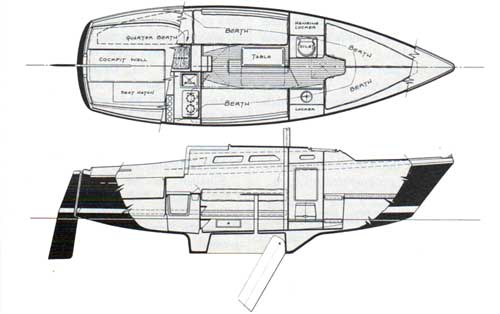
Sailing isn't just a means of transportation. You sail for the way it makes you feel, for the total experience. And the way your sailboat looks is bound to be part of the way you feel.
Besides, a boat's appearance often reflects the way she was built. If she's swift, seaworthy and honestly designed, a boat is nearly always pleasing to the eye. If she's a clunker, she probably looks it, too.
Here's how the O'Day 25 measures up:
- The graceful curve of the cockpit coaming is only one example of the way O'Day combines good looks with sensible engineering. It adds to the striking cabin profile, serves as a base for winches and keeps the cockpit of the O'Day 25 uncommonly dry.
- The cockpit itself is extra wide. Providing more than ordinary space for a 25-footer.
Suggested retail price for centerboard model O'Day 25 is $9,950. And unlike many boats she comes ready to sail. With sheets and halyards, main and jib.
And a lot of other gear that's ordinarily optional. A mainsheet traveler and a boom yang, for example. Options include an inboard motor -- rare among 25-footers.
Why the O'Day 25 Costs As Much As It Does
A sailboat has to stand extraordinary punishment. The pressure of rushing waves. The heavy stresses on her rig. The corrosive power of salt water.
Only uncommon materials will survive. But they're expensive. Stainless steel. Tempered Dacron sailcloth. Braided lines. Solid teak. All are specified for the O'Day 25.
Painstaking construction is also costly. Our hulls, for example, are made with hand layed up fiber glass. Others spray in chopped up fiber. Our way is stronger. Longer lasting. But it's more expensive.
The O'Day 20.
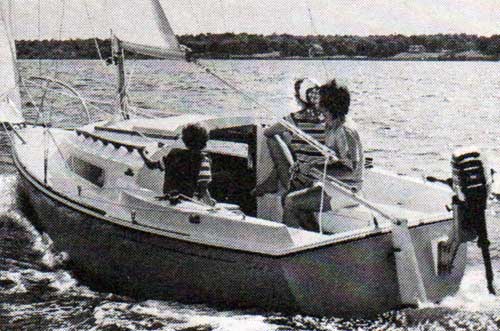
O'Day builds smaller cruisers, too. Like the O'Day 20. Four full-sized bunks, head, galley sink, icebox and optional stove make her self-sufficient away from port.
A tall rig and 3'11" draft (with centerboard down) make her a lively performer under sail. Four hundred pounds of lead ballast make her safely self-righting. And her shallow draft keel (14" centerboard up) and tabernacle stepped mast make her easy to trailer. Suggested retail price: $5,000.
The O'Day 22.
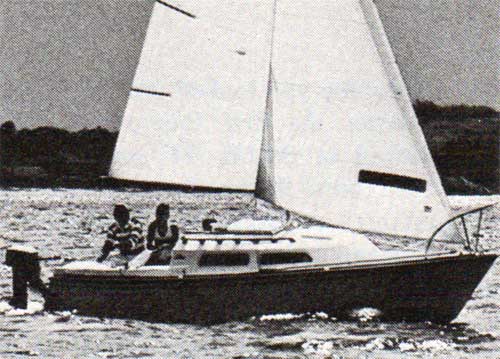
Another sensible alternative is the O'Day 22. A sailboat that so neatly fits a family's cruising needs that more than 2,000 have already been sold.
She's fitted with a shallow fixed keel for stability -- and easy launching from a trailer. And it lets her sail where full-keeled boats can't go. Two cabins below, a full galley and an enclosed head give her privacy and space for more than weekend cruising. And a hand layed up hull makes her tough and durable. Suggested retail price: $5,900.
Tall Rig and Fixed Keel
For skippers interested in MORC racing, the O'Day 25 is available with a two foot taller mast and an 1800-lb. fixed lead keel.
O'Day 25
A Bangor Punta Company
O'Day Information Center
Fall River, Mass. 02720
l enclose $1.00 for complete information on the O'Day 25.
I enclose $1.00 for booklet, "Have Fun Learning to Sail."
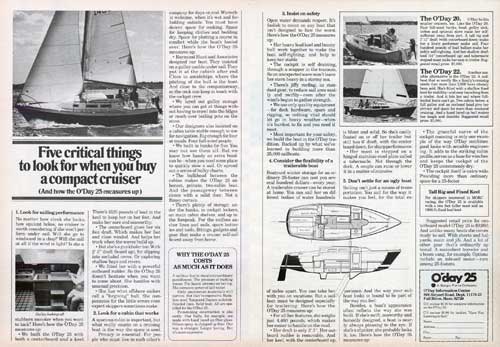
GGA REF: BPODY-025-1976-BW-AD-2
